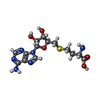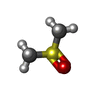+ Open data
Open data
- Basic information
Basic information
| Entry | Database: PDB / ID: 5vbc | ||||||
|---|---|---|---|---|---|---|---|
| Title | Crystal structure of ATXR5 in complex with histone H3.1 | ||||||
 Components Components |
| ||||||
 Keywords Keywords | TRANSFERASE/DNA BINDING PROTEIN / nucleosome / methylation / TRANSFERASE-DNA BINDING PROTEIN complex | ||||||
| Function / homology |  Function and homology information Function and homology information[histone H3]-lysine27 N-methyltransferase / histone H3K27 monomethyltransferase activity / chromocenter / plastid / histone acetyltransferase activity / chloroplast / transcription coregulator activity / structural constituent of chromatin / nucleosome / methylation ...[histone H3]-lysine27 N-methyltransferase / histone H3K27 monomethyltransferase activity / chromocenter / plastid / histone acetyltransferase activity / chloroplast / transcription coregulator activity / structural constituent of chromatin / nucleosome / methylation / protein heterodimerization activity / chromatin binding / regulation of transcription by RNA polymerase II / chromatin / DNA binding / extracellular region / zinc ion binding / nucleus / plasma membrane / cytosol Similarity search - Function | ||||||
| Biological species |  Ricinus communis (castor bean) Ricinus communis (castor bean) | ||||||
| Method |  X-RAY DIFFRACTION / X-RAY DIFFRACTION /  SYNCHROTRON / SYNCHROTRON /  MOLECULAR REPLACEMENT / Resolution: 2.1 Å MOLECULAR REPLACEMENT / Resolution: 2.1 Å | ||||||
 Authors Authors | Couture, J.-F. / Bergamin, E. | ||||||
 Citation Citation |  Journal: Nucleic Acids Res. / Year: 2017 Journal: Nucleic Acids Res. / Year: 2017Title: Molecular basis for the methylation specificity of ATXR5 for histone H3. Authors: Bergamin, E. / Sarvan, S. / Malette, J. / Eram, M.S. / Yeung, S. / Mongeon, V. / Joshi, M. / Brunzelle, J.S. / Michaels, S.D. / Blais, A. / Vedadi, M. / Couture, J.F. | ||||||
| History |
|
- Structure visualization
Structure visualization
| Structure viewer | Molecule:  Molmil Molmil Jmol/JSmol Jmol/JSmol |
|---|
- Downloads & links
Downloads & links
- Download
Download
| PDBx/mmCIF format |  5vbc.cif.gz 5vbc.cif.gz | 111.3 KB | Display |  PDBx/mmCIF format PDBx/mmCIF format |
|---|---|---|---|---|
| PDB format |  pdb5vbc.ent.gz pdb5vbc.ent.gz | 83.7 KB | Display |  PDB format PDB format |
| PDBx/mmJSON format |  5vbc.json.gz 5vbc.json.gz | Tree view |  PDBx/mmJSON format PDBx/mmJSON format | |
| Others |  Other downloads Other downloads |
-Validation report
| Arichive directory |  https://data.pdbj.org/pub/pdb/validation_reports/vb/5vbc https://data.pdbj.org/pub/pdb/validation_reports/vb/5vbc ftp://data.pdbj.org/pub/pdb/validation_reports/vb/5vbc ftp://data.pdbj.org/pub/pdb/validation_reports/vb/5vbc | HTTPS FTP |
|---|
-Related structure data
| Related structure data | 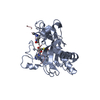 5va6C 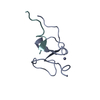 5vabC 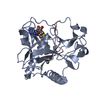 5vacC 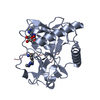 5vahC  4o30S C: citing same article ( S: Starting model for refinement |
|---|---|
| Similar structure data |
- Links
Links
- Assembly
Assembly
| Deposited unit | 
| ||||||||
|---|---|---|---|---|---|---|---|---|---|
| 1 | 
| ||||||||
| 2 | 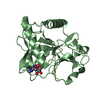
| ||||||||
| Unit cell |
|
- Components
Components
| #1: Protein | Mass: 26246.797 Da / Num. of mol.: 2 / Fragment: SET domain residues 146-374 Source method: isolated from a genetically manipulated source Source: (gene. exp.)  Ricinus communis (castor bean) / Gene: ATXR5, RCOM_1460410 / Production host: Ricinus communis (castor bean) / Gene: ATXR5, RCOM_1460410 / Production host:  References: UniProt: B9RU15, histone-lysine N-methyltransferase #2: Protein/peptide | Mass: 1345.590 Da / Num. of mol.: 2 / Fragment: residues 24-37 / Source method: obtained synthetically / Source: (synth.)  #3: Chemical | #4: Chemical | ChemComp-DMS / | #5: Water | ChemComp-HOH / | |
|---|
-Experimental details
-Experiment
| Experiment | Method:  X-RAY DIFFRACTION / Number of used crystals: 1 X-RAY DIFFRACTION / Number of used crystals: 1 |
|---|
- Sample preparation
Sample preparation
| Crystal | Density Matthews: 2.51 Å3/Da / Density % sol: 50.93 % |
|---|---|
| Crystal grow | Temperature: 277 K / Method: vapor diffusion, sitting drop Details: 50% polypropylene glycol 400, 100mM Na-Hepes pH 6.0 and 5% DMSO |
-Data collection
| Diffraction | Mean temperature: 100 K |
|---|---|
| Diffraction source | Source:  SYNCHROTRON / Site: SYNCHROTRON / Site:  APS APS  / Beamline: 21-ID-D / Wavelength: 1 Å / Beamline: 21-ID-D / Wavelength: 1 Å |
| Detector | Type: MARMOSAIC 300 mm CCD / Detector: CCD / Date: Oct 19, 2013 |
| Radiation | Protocol: SINGLE WAVELENGTH / Monochromatic (M) / Laue (L): M / Scattering type: x-ray |
| Radiation wavelength | Wavelength: 1 Å / Relative weight: 1 |
| Reflection | Resolution: 2.1→27 Å / Num. obs: 29410 / % possible obs: 98.3 % / Redundancy: 4.1 % / Rsym value: 0.06 / Net I/σ(I): 12.1 |
- Processing
Processing
| Software |
| ||||||||||||||||||||||||||||||||||||||||||||||||||||||||||||||||||||||||||||||||||||
|---|---|---|---|---|---|---|---|---|---|---|---|---|---|---|---|---|---|---|---|---|---|---|---|---|---|---|---|---|---|---|---|---|---|---|---|---|---|---|---|---|---|---|---|---|---|---|---|---|---|---|---|---|---|---|---|---|---|---|---|---|---|---|---|---|---|---|---|---|---|---|---|---|---|---|---|---|---|---|---|---|---|---|---|---|---|
| Refinement | Method to determine structure:  MOLECULAR REPLACEMENT MOLECULAR REPLACEMENTStarting model: 4o30 Resolution: 2.1→26.404 Å / SU ML: 0.25 / Cross valid method: FREE R-VALUE / σ(F): 0.49 / Phase error: 26.96
| ||||||||||||||||||||||||||||||||||||||||||||||||||||||||||||||||||||||||||||||||||||
| Solvent computation | Shrinkage radii: 0.9 Å / VDW probe radii: 1.11 Å | ||||||||||||||||||||||||||||||||||||||||||||||||||||||||||||||||||||||||||||||||||||
| Refinement step | Cycle: LAST / Resolution: 2.1→26.404 Å
| ||||||||||||||||||||||||||||||||||||||||||||||||||||||||||||||||||||||||||||||||||||
| Refine LS restraints |
| ||||||||||||||||||||||||||||||||||||||||||||||||||||||||||||||||||||||||||||||||||||
| LS refinement shell |
|
 Movie
Movie Controller
Controller




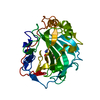
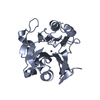
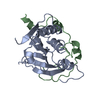
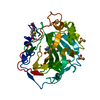





 PDBj
PDBj

